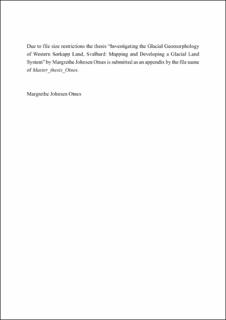| dc.description.abstract | The Arctic is warming almost four times faster than the rest of the world and will experience numerous changes in both the close and far away future due to global warming and climate change. Many of these changes are human-induced. The changes in the Arctic are intensified by the Arctic amplification. Svalbard, situated between the Greenland Sea and the Barents Sea, is largely affected by global warming as almost 60% of the archipelago is covered by glacial ice, with most glaciers currently retreating. Some Svalbard glaciers are surge type. There are many unknowns regarding surging glaciers and how they are affected by climate change. In Svalbard, many areas are difficult to access and in such areas, the use of remote imagery is particularly useful. Glacial geomorphology can give insight into the behaviour of glaciers and their characteristics. Here it is used to study landforms at the forelands of four glaciers in a north-to-south transect in the region Sørkapp Land in southern Spitsbergen. No detailed geomorphology maps exists of these glacial forelands.
Four glacial geomorphology maps were produced. The maps include landforms and glacial extents. Measurements for glacial retreat were conducted in ArcGIS Pro. A landsystem approach considered all four forelands as polythermal landsystems, with Bungebreen having landforms of both polythermal and surge-type. The landsystems defined the thermal regime of the glaciers and all four glaciers were deemed to be polythermal. Bungebreen is likely a surging polythermal glacier. The glacial geomorphology maps produced in this study were compared to a geomorphological map of the Hornsund region (scale 1: 75 000) published in 1984. Based on that map, geomorphological changes in the forelands of Gåsbreen, Bungebreen and Vitkovskijbreen were identified. The last glacier Belopol’skijbreen was not included in this map. Belopol’skijbreen, the most southern of the studied glaciers, have retreated most. Differences in landforms at the studied glaciers are likely caused by topographic differences, as well as variations in insolation. It appears that the glaciers of the study area are largely conforming with the landsystems of other retreating glaciers in Svalbard, indicated by ice melt-out and slope processes. However, the results of this study confirm the need for a landsystem for polythermal glaciers with tendencies to surge. From this study, it is clear that more research is needed on surging glaciers and how they will be affected by climate change. This study contributes valuable information on the land-based glacier in Sørkapp Land for further studies. Future studies should focus on how they and other glaciers in Svalbard respond to current climate change and how they will be affected by regional changes. | |

